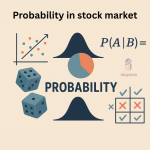Introduction
In finance and trading, we constantly deal with uncertainty – from the flip of a coin in a bet to the daily fluctuations of stock prices. Probability theory gives us a framework to understand and quantify this uncertainty. In this blog, we’ll break down some fundamental concepts of probability (like events and random variables) and see how they relate to real-world examples, including coin tosses and stock market movements. We’ll also explore different types of events (such as simple, compound, mutually exclusive, etc.) using stock market analogies, and discuss where stock index returns (like those of the Nifty 50) fit into this framework. The goal is to keep things intuitive and light on math – so whether you’re a general reader, a retail trader, or a finance enthusiast, you can grasp these concepts and see how they apply to markets.
What Is an Event in Probability?
In probability theory, an event is essentially a possible outcome or a set of outcomes of some random experiment. Formally, it’s defined as a subset of the sample space (all possible outcomes). For example, if you toss a fair coin, the sample space is {Heads, Tails}. The event “getting Heads” corresponds to one specific outcome in that sample space. In other words, “Heads” is an event that occurs if the coin lands showing heads. Similarly, the event “rolling an even number on a six-sided die” would include the outcomes {2, 4, 6} – a set of all even-face results.
To build intuition, consider events in everyday or market scenarios:
- Coin toss example: The event “Heads” on a coin toss is a simple event (it either happens or does not on a given toss). Another event could be “not Heads” (which in this case simply means Tails). You could also define a compound event like “getting 2 Heads in a row” if you toss a coin twice, which would occur only if the sequence Head, Head comes up.
- Stock market example: An event could be “Stock ABC’s price goes up today.” This event will occur if at market close the price is higher than yesterday’s close. Another event might be “Nifty 50 index ends the week above 25,000.” That event will occur (or not) depending on the week’s outcome. We can be even more specific: “Company X’s earnings beat expectations” is an event that might occur on an earnings release day, and it could be tied to another event, “Company X’s stock jumps 5%”. Notice that in markets, we often chain events (earnings results leading to price moves), which brings in the idea of dependence (we’ll cover that later).
In summary, an event is something that either happens or doesn’t when a random experiment is performed. We can attach probabilities to events (e.g., 50% chance of heads, or maybe 30% chance a stock will rise tomorrow based on some model). Crucially, events don’t have to be single outcomes – they can group multiple outcomes (like “rolling an even number” grouped {2,4,6}). Next, we’ll formalize that idea of simple vs. compound events.
What Is a Random Variable?
A random variable is a numerical quantity whose value is determined by the outcome of a random experiment. In plain terms, it’s a way to assign a number to each outcome of a random process. For example, consider the experiment “roll a die and note the result.” We can define a random variable X = “the number on the die face.” If you roll the die and it comes up 4, then X = 4 for that trial. If it comes up 1, X = 1, and so on. The value isn’t fixed ahead of time – it depends on chance (hence “random”). In finance, you can think of “the future price of a stock” as a random variable – it’s an unknown number that will be realized in the future based on various unpredictable factors. Likewise, “the return on an investment” is a random variable – you don’t know if it will be +10%, -5%, or something else until it happens.
Discrete vs. Continuous random variables: Random variables come in two flavors. A discrete random variable can only take specific, separate values (often counts or integers), whereas a continuous random variable can take any value within a range (infinitely many possibilities, often measured). An example of a discrete random variable in a finance context would be the number of winning trades out of 10 trades – it could be 0, 1, 2, …, up to 10 (you can count the possible values). Another example: the number of stocks in the Nifty 50 that went up today is discrete (anywhere from 0 to 50). You can’t have 13.5 stocks out of 50 go up – it’s either 13 or 14, etc. In contrast, a continuous random variable example is the daily return of a stock index (like the percentage change in the Nifty 50 on a given day). That return could be any real number (within some range); e.g., +0.75%, -1.20%, +2.5%, etc., with theoretically infinite gradations. In practice, even stock prices – which we often treat as continuous – have a smallest tick size (like ₹0.05 or ₹0.01), meaning prices move in discrete jumps. Thus, technically, a stock price can be viewed as a discrete random variable restricted to those tick increments. However, for most practical analyses, those increments are so small that we model price changes or returns as continuous. In summary, if you can list out all possible values (even if infinite but countable), it’s discrete; if it can smoothly be any value in an interval, it’s continuous. Many financial variables (like returns, interest rates, etc.) are treated as continuous for ease of modeling.
Why random variables are useful: They allow us to use the tools of math and statistics to quantify uncertainty. Instead of saying “I’m not sure what will happen,” we define a random variable (like “X = tomorrow’s Nifty 50 return”) and talk about its distribution: perhaps X has a probability of being positive or negative, an expected value (mean), and so on. We’ll see next how events tie into this – essentially, an event can be viewed as a statement about a random variable (e.g., event A = “X > 0” is the event that the return is positive).
Types of Events in Probability (with Stock Market Analogies)
Not all events are created equal. Events can be classified based on how they relate to each other or how they are formed from outcomes. Let’s go through some key types of events and explain each with a stock market or trading analogy:
- Simple Event: A simple event corresponds to a single outcome of an experiment. There’s no further breakdown – it’s a basic outcome. For example, getting Heads on a coin toss is a simple event (only that outcome qualifies). In a stock context, a simple event might be “Nifty 50 closes at 25,000 exactly on Friday” – a very specific outcome. Or “Stock ABC’s price ends up ₹5” (exact match). These are single-outcome events. Another practical example: “ABC Corp’s stock closes in the green (positive) today” could be considered a simple event if we define the outcome of interest as either “up” or “down”. In that case, “up” is one outcome (event) and “down” is another. Simple = one outcome.
- Compound Event: A compound (or composite) event involves two or more outcomes combined together. This could mean the event is defined by several conditions or a sequence of simple events. For instance, “getting two heads in two coin tosses” is a compound event – it requires Head on toss 1 and Head on toss 2 (a combination of two outcomes). In trading, an example compound event might be “Stock ABC goes up on both Monday and Tuesday.” This event will occur only if ABC’s price rose on Monday’s close and again rose on Tuesday’s close. Another example: “At least 3 out of 5 tech stocks in my watchlist go up this week.” That event consists of multiple basic outcomes (various combinations where exactly 3, 4, or 5 stocks rise). We often use and/or logic for compound events (AND for the intersection of events, OR for the union of events). For instance, “Nifty 50 rises this week AND the USD/INR exchange rate falls this week” is a compound event requiring both conditions to happen together.
- Mutually Exclusive Events: Events are mutually exclusive if they cannot occur at the same time. In other words, the occurrence of one event means the other cannot possibly occur in that same instance. A classic example: in a single die roll, the events “roll a 3” and “roll a 5” are mutually exclusive – you can’t roll both a 3 and a 5 on the same single die roll. Translated to stocks, consider the events “Stock XYZ closes above ₹100 today” and “Stock XYZ closes below ₹100 today.” Those two are mutually exclusive – at the closing bell, the price can either be above ₹100 or below ₹100 (it can’t be both at once). (Note: if it closes exactly at ₹100, that’s technically neither event in this formulation – which is fine, or we could include an event for exactly ₹100 – the point is, no single outcome falls into both categories.) Another example: “Market closes up” vs “Market closes down” on a given day are mutually exclusive events – a day’s overall index performance can’t be simultaneously up and down. However, mutually exclusive does not mean the events are unrelated – it simply means they don’t overlap. In fact, mutually exclusive events are often very related (they’re essentially opposites or alternatives). If one happens, the other definitely does not. A key consequence: if A and B are mutually exclusive,
P(A AND B)=0Often, we also talk about either/or situations: if events are mutually exclusive, the probability of A or B happening isP(A)+P(B)(since there’s no overlap). - Exhaustive Events: A set of events is exhaustive (sometimes “collectively exhaustive”) if at least one of the events must occur in each trial – together they cover all possible outcomes. For example, when you flip a coin, the events “Heads” and “Tails” are collectively exhaustive because those outcomes cover the entire sample space – every coin toss is either heads or tails (assuming it can’t land on edge). In a six-sided die, the outcomes 1 through 6 are exhaustive – you will always get one of those numbers on a fair throw. In finance, we could say “market goes up,” “market goes down,” or “market stays unchanged” are collectively exhaustive for the market’s daily direction (assuming “up” means any positive change, “down” means any negative change, and “unchanged” means no change). One of those will happen each day, so they cover all possibilities. Exhaustive events are useful when defining sample spaces and ensuring probabilities sum to 1. For instance, if we consider an event A = “Nifty goes up or stays flat” and event B = “Nifty goes down,” these two events together are exhaustive – on any given day, either A or B will occur. If we assign probabilities,
P(A)+P(B)=1In that case (100% of days either the market does not fall or it falls). - Dependent Events: Two events are dependent if the occurrence of one affects the probability of the other. In everyday terms, there is some kind of connection or influence between them. A classic probability example: drawing cards from a deck without replacement – the event “first card is an Ace” and “second card is an Ace” are dependent because if the first card was an Ace, it changes the composition of the deck (one less Ace remaining) and thus affects the probability of the second card being an Ace. In the stock market, dependence is often seen via causal links or correlated outcomes. For instance, consider Event A: “Company X announces a hugely positive earnings surprise” and Event B: “Company X’s stock price rises by 5% today.” These events are dependent – if A occurs, the probability of B occurring increases dramatically (good news makes a stock jump is more likely). Conversely, if the earnings are bad, the chance of a big price rise (Event B) drops. As another example, “Oil prices drop 10%” and “Energy sector stocks fall on the same day” are dependent – the occurrence of the first event directly influences the likelihood of the second. Dependence can also be more subtle: “Market rises today” and “Market rises again tomorrow” might be dependent if, say, positive momentum or investor sentiment carries over (one day’s gain could slightly improve the odds of the next day’s gain, or in statistical terms, there could be autocorrelation). Key point: With dependent events, knowing that one happened changes the odds for the other.
- Independent Events: Two events are independent if they have no influence on each other’s occurrence. If Event X and Event Y are independent, that means P(X occurs) is the same whether or not Y happens (and vice versa). A classic example: separate coin flips – the result of the first flip (Event X = “first flip is heads”) does not affect the result of the second flip (Event Y = “second flip is heads”). In probability terms,
P(X and Y)=P(X)×P(Y)if X and Y are independent. In finance, suppose you have two completely unrelated stocks or bets – Event A: “ABC stock hits a new high today” and Event B: “You win a lottery today.” These have nothing to do with each other; the stock doesn’t care about your lottery ticket, and the lottery outcome doesn’t influence the stock price. So we’d treat them as independent events. Another example: “Nifty 50 goes up today” and “Dow Jones (US) goes up today” – are these independent? In reality, global markets often have some correlation (so they might be somewhat dependent). But if we considered something like “Nifty goes up” and “It rains in Mumbai today,” those are basically independent – weather doesn’t move the stock market in any consistent way! Independence is an assumption that greatly simplifies analysis. Often, for modeling, we assume independence if there’s no clear reason for a relationship, even if in reality there might be a mild one. For traders, recognizing independence vs dependence matters: if two events or positions are independent, the risks don’t overlap; if they’re dependent, you effectively have a concentrated bet.
It’s worth noting that mutually exclusive and independent are different concepts. Mutually exclusive events can’t happen together by definition (which usually creates a dependence – if one happened, you know the other did not). Independent events can happen together, but the occurrence of one gives no information about the other. For example, the events “rain tomorrow” and “Nifty goes up tomorrow” are not mutually exclusive (both could happen on the same day), and many would assume they’re independent (rain probably doesn’t affect the broad index). On the other hand, “Nifty hits all-time high tomorrow” and “Nifty falls 5% tomorrow” are mutually exclusive (the index can’t simultaneously do both), and knowing one happened tells you the other didn’t (they have a sort of negative dependence due to exclusivity). Always be clear on the context when identifying event relationships in probability.
Stock Price Return Outcomes and the Event Framework (Nifty 50 Case)
Histogram of daily returns for the Nifty 50 index. Most days’ returns cluster around the center (near 0%), forming a bell-shaped curve, with fewer days having extreme gains or losses. We did this experiment in an earlier blog as well.
Let’s bring it all together by examining the daily stock price returns of a major index, such as the Nifty 50 (a well-known index of 50 large, liquid stocks in India). Where do these returns fit in our probability framework?
- Event A: “Nifty’s daily return is positive (R > 0).”
- Event B: “Nifty’s daily return exceeds +2%.”
- Event C: “Nifty’s daily return is between -1% and +1%.”
First, each day’s return (say, the percentage change in the Nifty 50 from yesterday’s close to today’s close) can be viewed as the outcome of a random variable. We might define a random variable Rdaily = “today’s Nifty 50 return.” Before the market opens, Rdaily is unknown – it could end up being +0.5%, -1%, +2%, -0.2%, etc. When the closing bell rings, we get a realized value (outcome) for that random variable. Over time, as we observe many days, Rdaily will take on different values, and we can talk about its distribution. Empirical analysis and theory often suggest that index returns are approximately normally distributed (the classic “bell curve”), centered around a modest mean with a certain volatility. The histogram above illustrates this: most daily returns are near 0%, and extreme moves are rarer (though markets do have somewhat fatter tails than an ideal normal distribution, meaning big moves happen a bit more often than a perfect bell curve would predict – traders call these “fat tails” or “black swan” events). The key point is that we treat the daily return as a continuous random variable – it’s not just up or down; it has a magnitude, and theoretically any percentage value is possible within some range. We could define various events in terms of this random variable, for example:
Each of these is an event (a subset of outcomes) related to the random variable Rdaily. We can attach probabilities to them by looking at historical frequency or a probability model. For instance, based on historical data, you might say P(R>0)P(R > 0)P(R>0) (Probability the day is positive) It is around, say, 55% (just hypothetically) because markets have had a slight upward bias over long periods. Or P(R<−2%)P(R < -2\%)P(R<−2%) it might be X% based on how often the market drops that much.
Now, are these daily return events independent or dependent? This is a crucial question in financial modeling. A simplifying assumption often made (especially under the random walk hypothesis in an efficient market) is that day-to-day returns are independent of each other. In practical terms, this means the fact that the Nifty was up today doesn’t significantly change the probability that it will be up (or down) tomorrow – each day’s movement is like a fresh random draw. This assumption underpins a lot of financial theory, including the idea that you “can’t predict the market” from past patterns (at least in the short term). If successive price changes are independent random variables, the series of returns has no memory – yesterday’s gain or loss doesn’t inherently make today’s outcome any easier or harder to guess. High liquidity and broad diversification in an index like Nifty 50 support this independence assumption, because any single day’s movements are the net result of many news events and trader actions that are hard to repeat exactly. In an idealized model, Nifty’s daily returns would be independent and identically distributed (IID) random variables – identically distributed meaning each day follows the same probability distribution (same volatility, etc.), and independent meaning no autocorrelation from one day to the next.
However, it’s worth noting reality can be a bit messier. Markets sometimes exhibit dependence between days – for example, volatility clustering (after a big move, the market might be more likely to have another big move, indicating yesterday’s volatility influences today’s). There may also be short-lived momentum or mean-reversion, where returns show slight correlations. But for a high-liquidity index like Nifty, these effects are usually small and often short-term. For conceptual understanding, it’s reasonable to treat daily returns as independent events. Each day is a new roll of the dice, so to speak. If we consider the event “today’s return is X” (some specific value or range), and “tomorrow’s return is Y”, in an independent model P(X and Y)=P(X)×P(Y). In a dependent world, that wouldn’t hold strictly. Traders certainly debate these nuances (trend-followers vs. random-walk believers), but that goes deeper into strategy. From a probability theory standpoint, Nifty 50 returns are random variables (continuous), and individual daily return outcomes can be considered simple events (each day gives one outcome). An event like “the market is up 3 days in a row” would be a compound event (sequence of three simple events), and here you’d need to consider whether each day’s outcome is independent of the last to calculate its probability.
Summary: The daily returns of a stock index like Nifty 50 sit nicely in the probability framework. We model each return as a random variable with a distribution (often roughly normal. Specific conditions on returns (positive, negative, large drop, etc.) are events to which we can assign probabilities. And for a well-developed market index, assuming those events are independent from day to day is a useful first approximation. This means one day’s return doesn’t guarantee or preclude the next day’s outcome – much like successive coin flips. Understanding this helps traders grasp why “past performance is not indicative of future results” in a very literal, probabilistic sense. Each trading day is a new event with its own uncertainty, and probability theory is the tool that helps us navigate that uncertainty with concepts like events and random variables.
Conclusion
Probability theory provides a language to discuss uncertainty in trading and finance. We learned that an event is essentially something that either happens or does not (a set of outcomes), and a random variable gives structure to numerical outcomes of random processes (like stock returns). We saw different types of events – from simple and compound events to relationships like mutually exclusive, exhaustive, dependent, and independent events – each with intuitive examples ranging from coin tosses to stock scenarios. Finally, we placed stock index returns (like those of Nifty 50) into this framework, recognizing them as random variables with (approximately) bell-curve distributions, and often treating daily return events as independent across time in an efficient market.
For traders and investors, these concepts aren’t just abstract theory – they underlie practical ideas like diversification, risk management, and statistical trading strategies. For example, knowing events can be dependent might make you cautious about putting all your investments in highly correlated stocks (their moves won’t be independent events, meaning you’re not as diversified as you think). Understanding that stock returns have a distribution (and roughly what shape it is) helps in assessing risk (e.g., how likely a big loss or “sigma event” might be. And recognizing that we often assume independence day-to-day can remind you why “past trend” might not automatically continue. Overall, a solid grasp of these probability basics can improve how you think about trading outcomes – making the randomness of markets a bit less mysterious and a bit more quantifiable. Happy trading, and may the probabilities be in your favor!
In the upcoming post, we will discuss different probability functions used by institutional traders in trading.






Manoj g, wonderfull article, and you are explaining concepts which prodesk uses as their quant analysis. I have a request, can you add nex article, with live example. That will help.
Superb! Can you now add the various types of actual events from past experience and categorize them. Also if you can add any new events which can be forecasted.